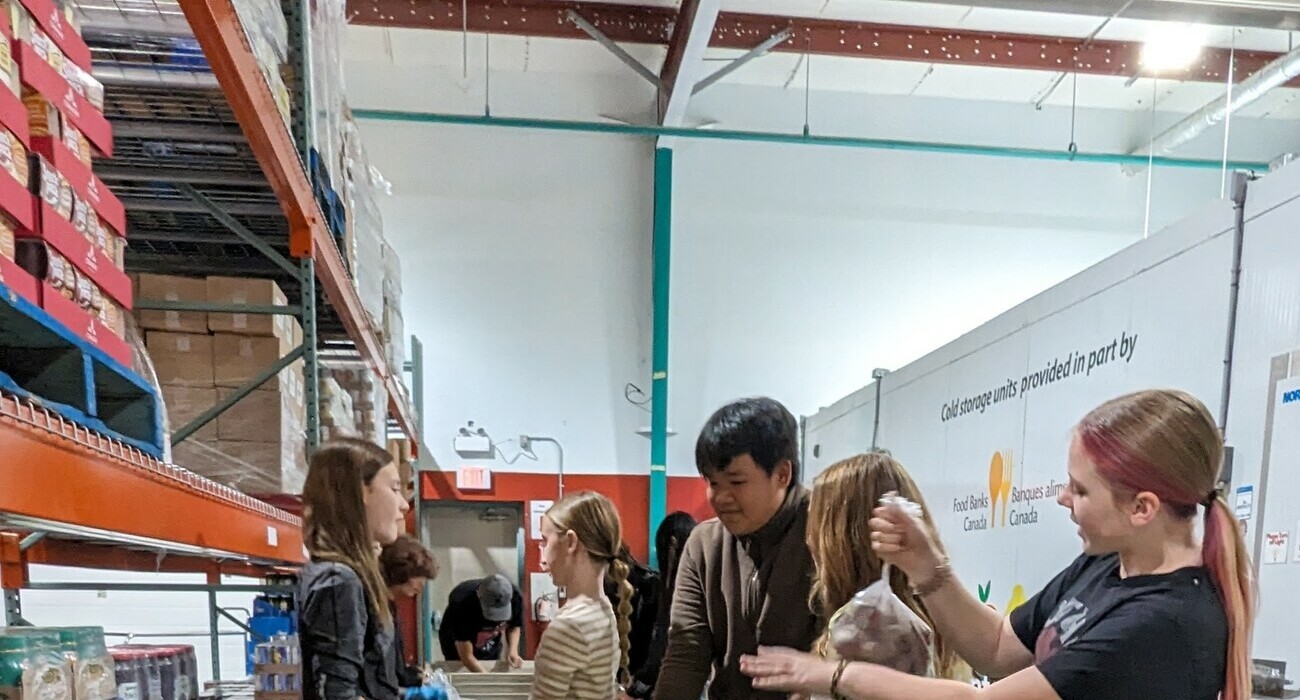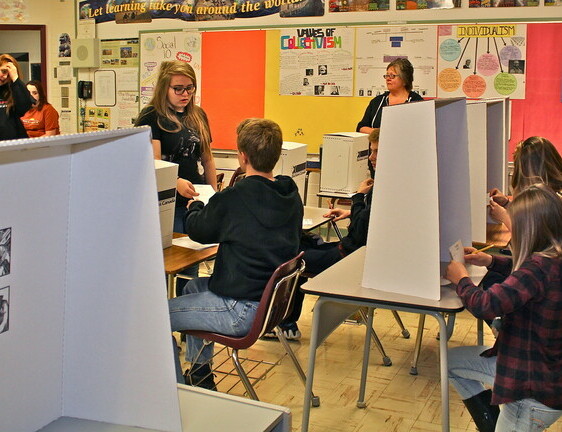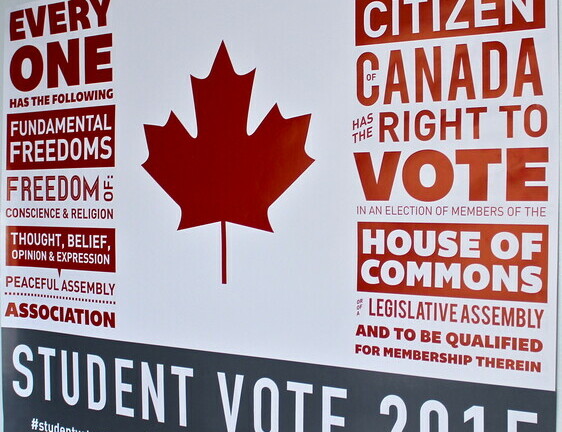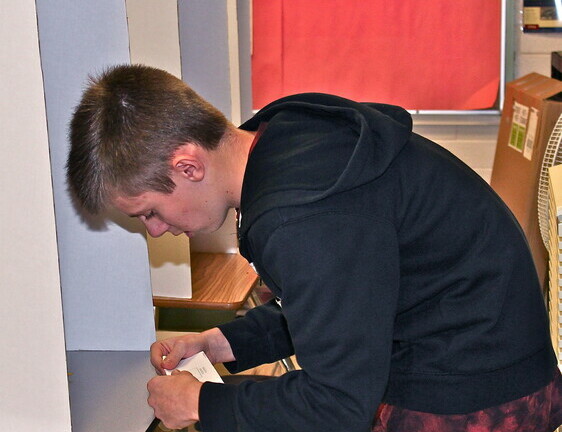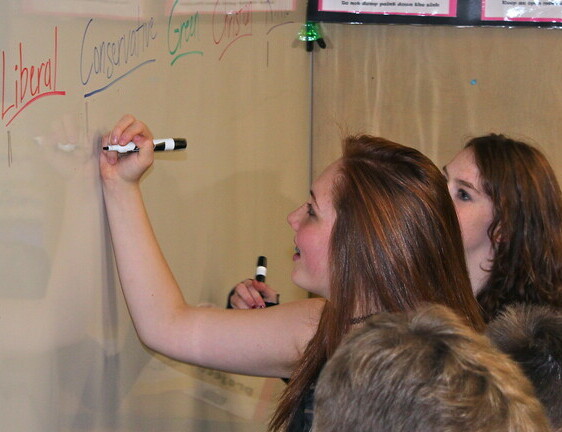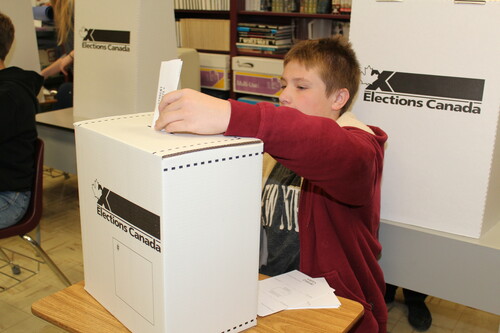
Student Vote will not only serve Coalhurst High School students well in exams this year, but in their own roles as engaged citizens for years to come.
Led by a Grade 9 Social Studies class currently learning about Canadian government, the exercise allowed the entire student population a chance to take part in a mock election that paralleled the federal campaign.
Teacher Michael Saad sees it as a “kick-start” for students who will be voting for real in a few more years.
“It’s something that appeals to them because they see Student Vote as practice almost, like ‘now here’s my chance,’ ” he says. “You take that Student Vote piece out of there, now all of a sudden voting is something foreign to them and I think that does generate a lot of apathy.”
Eighteen Palliser Regional Schools were among more than 6,000 schools across Canada taking part in Student Vote, which has offered students learning materials, ballot boxes and the like since 2003. The program is offered free of charge thanks to a partnership between CIVIX, a civic education organization, and Elections Canada.
The exercise wrapped up the Friday before the actual election, with the Grade 9 students all assigned roles on Vote Day including deputy returning officers, pollsters, security and party scrutineers. Efforts were made to keep the experience as authentic as possible although a few concessions were made, including political party posters at the polling stations so student-voters could bone up on platforms if needed.
The Coalhurst High election saw a voter turnout of 78 per cent, well above the national mark of 68 per cent. Although numbers were down a little at CHS because some of the older students had spares that period, Saad noted there was also increased interest since alumni Kas MacMillan was running as the Green Party candidate in the Lethbridge riding.
“It’s exciting to have Kas running. It’s like ‘here’s a student just like you, who took this very course in this very room, and here he is now running to be your Member of Parliament,’ ” he says.
Student Renae Mundel liked some of the Green Party’s platform – including a reduction in post-secondary tuition – but that wasn’t enough to sway her decision.
“I don’t want to be rude, but I don’t think they are in the front running so I think it would be a waste of a vote,” she says.
Instead the 14-year-old voted Conservative, at least in part because of the other parties’ opposition to anti-terrorism bill C-51.
“I think it’s pointless because in my opinion they are putting us in danger because a lot of the refugees might be terrorists acting as refugees, and just trying to get into our country. I don’t know what other way they could protect us besides that,” says Mundel.
Like his classmate, Colton Kooiker says Student Vote inspired him to take part in the democratic process when it’s his turn. He too voted Conservative.
“I just didn’t like how the Liberals and the Greens were going to legalize marijuana. And I didn’t like what the NDP were going to do, so I decided to stick with the Conservatives,” he says.
Going into the final day of the campaign Saad had boasted how the Student Vote results at CHS had mirrored the official outcome every year since the school participated in 2004, both in predicting the winner and how the other parties finished in the local riding for both federal and provincial elections.
That streak was snapped Monday night. While students correctly had the Conservative candidate winning the Lethbridge riding, they had the Green candidate, MacMillan, second while the New Democratic Party was runner-up in real life.
To see Student Vote results from all 18 Palliser schools which took part, go to http://goo.gl/hjqLQi
Whether the Green vote was inspired by their alumni or not, Saad did note one particular issue that seemed to capture the students’ attention this campaign, climate change and the environment. He says students are finally starting to understand this planet is going to be handed down to them and it’s not in great shape.
“Traditionally, global warming is hard to teach because the kids are growing up in the midst of it and they really don’t know what happened before,” he says. “It was like growing up in the Cold War for us. ‘It’s been going on forever, so what’s the big deal?’ ”
Kooiker learned the importance of an accurate vote count – after inconsistencies forced a third reckoning at CHS – and Mundel was shocked that some of the issues on party platforms could possibly be of interest to anyone.
Many students were surprised to learn they can’t vote directly for the prime minister and others realized the process can be somewhat “cumbersome.” That, in turn, leads to talk about such issues as online voting, mandatory voting and being paid to vote, and whether proportional representation is feasible.
“Right there you are getting into critical outcome thinking,” says Saad of the additional benefits of the exercise.
While some real-life voters may grumble about going to the polls so often, he says those Social Studies students certainly benefit.
“It really takes on more meaning and it’s a lot more fun to connect it to a real-world issue. When there’s no election, it’s a little harder to get them motivated,” Saad says.
For more information on Student Vote, go to http://studentvote.ca/

